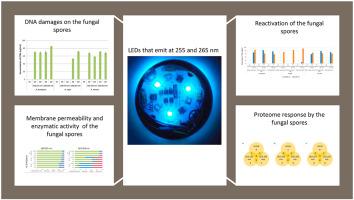当前位置:
X-MOL 学术
›
Environ. Pollut.
›
论文详情
Our official English website, www.x-mol.net, welcomes your feedback! (Note: you will need to create a separate account there.)
Light-emitting diodes effect on Aspergillus species in filtered surface water: DNA damage, proteome response and potential reactivation
Environmental Pollution ( IF 8.9 ) Pub Date : 2021-06-09 , DOI: 10.1016/j.envpol.2021.117553 Beatriz R Oliveira 1 , Ana P Marques 2 , Muhammad Asif 2 , Maria T B Crespo 1 , Vanessa J Pereira 1
Environmental Pollution ( IF 8.9 ) Pub Date : 2021-06-09 , DOI: 10.1016/j.envpol.2021.117553 Beatriz R Oliveira 1 , Ana P Marques 2 , Muhammad Asif 2 , Maria T B Crespo 1 , Vanessa J Pereira 1
Affiliation

|
DNA damage and changes in proteome response can occur as a consequence of UV light exposure. The emerging light-emitting diodes (LEDs) can be acquired with different wavelengths. In this study, LEDs that emit at 255 nm and 265 nm were selected to test the DNA damage and proteome response after inactivation of , and spiked into filtered surface water. Additionally, photoreactivation and dark repair studies were performed to evaluate the potential ability of the spores to recover after UV exposure. Results showed that both LEDs were able to induce the formation of cyclobutane pyrimidine dimers in and whereas, for , the formation of cyclobutane pyrimidine dimers was only detected when the LEDs that induced inactivation (that emit at 265 nm) were used. Proteome response showed that UV radiation treatment triggered different types of stress response, mainly concerning the protection from oxidative stress by and . Photoreactivation was detected for all the species except and, no dark repair was observed.
中文翻译:

发光二极管对过滤地表水中曲霉菌的影响:DNA 损伤、蛋白质组反应和潜在的重新激活
紫外线照射可能会导致 DNA 损伤和蛋白质组反应发生变化。新兴的发光二极管 (LED) 可以获得不同波长的光。在这项研究中,选择发射 255 nm 和 265 nm 波长的 LED 来测试 和 灭活后的 DNA 损伤和蛋白质组反应,并将其掺入过滤的地表水中。此外,还进行了光活化和暗修复研究,以评估孢子在紫外线照射后恢复的潜在能力。结果表明,两种 LED 均能够诱导 和 中环丁烷嘧啶二聚体的形成,而对于 ,仅当使用诱导失活(在 265 nm 处发射)的 LED 时才检测到环丁烷嘧啶二聚体的形成。蛋白质组反应表明,紫外线辐射治疗引发了不同类型的应激反应,主要涉及通过 和 来保护免受氧化应激。除 和 之外,所有物种均检测到光活化,未观察到暗修复。
更新日期:2021-06-09
中文翻译:

发光二极管对过滤地表水中曲霉菌的影响:DNA 损伤、蛋白质组反应和潜在的重新激活
紫外线照射可能会导致 DNA 损伤和蛋白质组反应发生变化。新兴的发光二极管 (LED) 可以获得不同波长的光。在这项研究中,选择发射 255 nm 和 265 nm 波长的 LED 来测试 和 灭活后的 DNA 损伤和蛋白质组反应,并将其掺入过滤的地表水中。此外,还进行了光活化和暗修复研究,以评估孢子在紫外线照射后恢复的潜在能力。结果表明,两种 LED 均能够诱导 和 中环丁烷嘧啶二聚体的形成,而对于 ,仅当使用诱导失活(在 265 nm 处发射)的 LED 时才检测到环丁烷嘧啶二聚体的形成。蛋白质组反应表明,紫外线辐射治疗引发了不同类型的应激反应,主要涉及通过 和 来保护免受氧化应激。除 和 之外,所有物种均检测到光活化,未观察到暗修复。


























 京公网安备 11010802027423号
京公网安备 11010802027423号